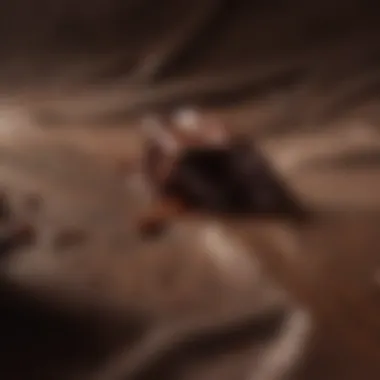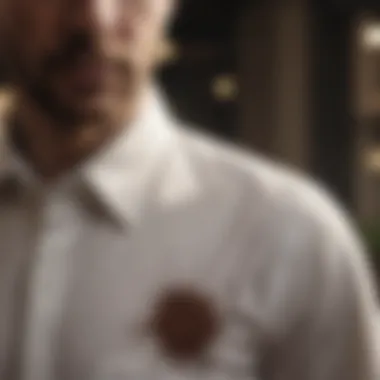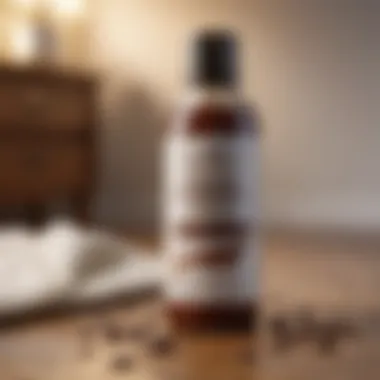Expert Strategies for Removing Chocolate Stains


Intro
Chocolate stains can pose a significant challenge for individuals who wish to maintain the integrity of their shirts. These stains are notorious for their stubbornness and can easily ruin a prized garment. However, understanding the strategies to effectively remove chocolate stains can save both time and effort. This article aims to provide a comprehensive guide on how to tackle these stains, focusing on immediate actions, cleaning techniques, and long-term garment care. By following these strategies, homeowners and individuals alike can ensure their clothing remains pristine, regardless of the occasional mishaps involving chocolate.
Key Insights and Trends
When it comes to stain removal, there are several insights worth noting. The approach to care and maintenance of clothing has evolved, with an increasing emphasis on sustainability and the use of eco-friendly products. Using natural cleaning agents not only benefits the environment but also preserves the fabric quality of garments, ensuring longevity. Many consumers are now opting for brands that offer biodegradable cleaners or those that utilize plant-based ingredients.
Additionally, there is a rise in awareness regarding personal care products. Removing stains promptly is crucial. It’s advisable to act quickly before the chocolate fully adheres to the fabric. This approach aligns with popular trends in home care that focus on immediate action to prevent permanent damage.
"Acting swiftly can make a significant difference in removing stubborn stains."
Practical Tips and How-To Guides
Here are several effective methods and practices for removing chocolate stains from shirts promptly:
Immediate Actions
- Remove Excess Chocolate: Use a dull knife or a spoon to gently scrape off any excess chocolate. Be careful not to push the chocolate deeper into the fabric.
- Cold Water Rinse: Rinse the stained area under cold water, letting the water flow through the back of the fabric to help push the chocolate out.
Cleaning Techniques
- Laundry Detergent: Apply a small amount of liquid laundry detergent directly to the stain. Gently rub it in with your fingers, allowing it to sit for at least 5 minutes.
- Stain Remover: For stubborn stains, consider using a specialized stain remover like OxiClean MaxForce. Follow the product's directions for effective results.
- Soak in Cold Water: After treating the stain, soak the shirt in cold water for about 30 minutes.
- Wash Normally: Finally, wash the shirt according to the care label instructions, using cold water to minimize the risk of setting the stain.
Taking these steps helps in comprehensive care, maintaining your garments while ensuring that chocolate stains are effectively removed.
Long-Term Care
To prevent future stains from becoming problematic, consider the following strategies:
- Stain-Repellent Treatments: Some shirts come with stain-repellant coatings that help prevent stains from soaking in. Investing in such clothing can be beneficial, especially for those who often consume chocolate or similar foods.
- Proper Garment Care: Regularly follow fabric care guidelines to maintain the quality of shirts. Regular inspections for stains can also help in addressing any issues before they become permanent.
By implementing these practical tips and understanding the insights surrounding stain removal, individuals can maintain the functionality and appearance of their favorite shirts, despite the inevitable chocolate mishaps.
Prolusion to Chocolate Stains
Dealing with chocolate stains on shirts can be a daunting task. Understanding the intricacies of these stains is crucial for effective removal. Chocolate, a beloved treat, often finds its way onto clothing during enjoyment, leading to potential frustration. This section highlights the necessity of recognizing chocolate composition and the characteristics of staining in order to tackle removal strategies effectively.
Understanding Chocolate Composition
Chocolate is primarily composed of cocoa solids, cocoa butter, sugar, and sometimes milk. Different types of chocolate, such as dark, milk, or white chocolate, have varying formulations. Each of these components reacts to fabric differently. For instance, cocoa solids contain pigments that can leave dark stains, while fat from cocoa butter can create oily spots.
Notably, the sugar content can contribute to stickiness, making it challenging to clean. The complexity of chocolate composition means that a one-size-fits-all solution for stain removal may not work. Identifying the type of chocolate involved in the stain can guide the selection of the most effective cleaning method.
The Nature of Staining
Staining occurs when a substance adheres to the fibers of the fabric, creating discoloration. Chocolate stains are particularly stubborn due to their combination of pigments and fats. When chocolate comes into contact with a shirt, it can penetrate deep into the fibers, especially if left untreated. Delaying action can result in the stain setting into the fabric, making removal much more difficult.


The environmental factors also play a role. For example, temperature and moisture can impact how deeply stains embed into fabric. A warm, humid environment may facilitate faster absorption of the chocolate into the fibers, while a cold, dry area may allow for easier removal if addressed quickly.
Understanding these components is essential as it informs the choice of cleaning techniques and helps prevent making the stain worse. By knowing how chocolate interacts with fabric, homeowners and others can adopt the best strategies to keep their clothing looking pristine.
Immediate Response to Chocolate Stains
Addressing chocolate stains swiftly is essential. The longer the stain remains, the more challenging it becomes to remove. Immediate actions can effectively minimize the problem and save the shirt from permanent damage. Timely intervention is a key factor that can determine success in stain removal.
Act Quickly
When a chocolate stain occurs, your first step should be to act without delay. It is important to recognize that chocolate contains fats and sugars that can seep into the fabric quickly. The sooner you respond, the higher the chance that you will lift the stain with less effort. Waiting too long can cause the stain to set, making it require more aggressive cleaning methods.
Scooping Off Excess Chocolate
After noticing a stain, the next step is to gently scoop off any excess chocolate. Use a dull knife or a spoon to lift away the solid pieces without grinding them into the fabric. This act is crucial as it prevents the stain from spreading. Be careful not to rub the area; instead, focus on outward motions from the center of the stain. Any small particles or clumps should be discarded. This makes the subsequent cleaning steps much more effective.
Rinsing the Stain
Once you have removed the excess chocolate, it is critical to rinse the stained area immediately. Use cold water, as hot water can cause the fats in chocolate to bind more firmly to the fabric. Place the fabric under running water with the stain facing down. This helps to push the chocolate out of the fibers rather than deeper into them. Rinse thoroughly to allow as much of the chocolate to escape as possible. Doing this prepares the fabric for further cleaning treatments, ensuring a better outcome.
Choosing the Right Cleaning Method
Choosing the correct cleaning method is crucial when it comes to removing chocolate stains from shirts. The approach you take can significantly impact the stain’s removal success and preserve the quality of the fabric. Different methods may suit various types of chocolate stains, and recognizing these differences can save time and effort. Understanding the properties of the stain and the garment will help you select the most effective strategy.
Water Temperature Considerations
Water temperature plays a significant role in stain removal. Cold water is usually recommended for chocolate stains because hot water can set the stain further into the fibers. The protein content in chocolate responds poorly to heat, making it harder to remove. Begin your cleaning process with cold water to lift the stain gently without causing damage. It is essential to understand the fabric type before applying any water treatment, as some materials may respond differently to temperature variations.
Commercial Stain Removers
Commercial stain removers offer a range of products designed for specific types of stains, including chocolate. These cleaners often contain enzymes and surfactants that break down the stain at a molecular level. When using such products, carefully follow the instructions on the label to achieve optimal results. Unlike home remedies, commercial stain removers are formulated to tackle more stubborn stains but may not be suitable for all fabric types. Always test a small area first to ensure the fabric will not be damaged.
Home Remedies for Chocolate Stains
Home remedies provide a convenient and cost-effective alternative for chocolate stain removal. Many homeowners may prefer these solutions, especially when they want to avoid harsh chemicals. Here are several effective methods:
Using Dish Soap
Using dish soap is a popular home remedy for chocolate stains due to its grease-cutting properties. Dish soap can effectively break down the oils present in chocolate, making it easier to remove. This soap is typically safe for most fabrics, making it a practical choice for general use. Simply mix one part dish soap with two parts cold water, apply it to the stain, and gently blot. However, it is important to rinse thoroughly to avoid leaving soap residue, which could attract dirt.
Baking Soda Application
Baking soda is another home remedy that is highly regarded for stain removal. Its abrasive texture can lift stains from fabric without causing damage. To use baking soda, create a paste by mixing it with water and apply it directly to the chocolate stain. Allow it to sit for about 15 minutes before rinsing. This remedy is particularly effective for older, set-in stains. However, baking soda alone may not lift every type of stain completely, especially those that have been exposed for longer periods.
Vinegar Solutions
Vinegar is a multi-purpose cleaner known for its ability to dissolve stains. When applied to chocolate stains, it can help to break down residues that may be otherwise difficult to remove. A mixture of equal parts white vinegar and cold water can be used to treat the stain. Apply the solution to the affected area and blot gently. While vinegar is effective, its scent might not be ideal for everyone, and it may require additional washing to remove its lingering aroma.


Remember: Always conduct a patch test before applying any cleaning method on a garment to prevent damage. The right technique can lead to successful stain removal, preserving your clothing's fabric integrity.
Step-by-Step Guide to Remove Chocolate Stains
Understanding how to effectively remove chocolate stains is crucial for maintaining the integrity of your garments. Chocolate, while delicious, often leaves behind stubborn stains that can ruin your favorite shirts. This section provides a systematic approach to remove these stains, simplifying the process and enabling better results.
Preparation of Cleaning Materials
Before attempting to remove a chocolate stain, gather all necessary cleaning materials. This preparation ensures you have everything on hand and can act quickly, which is vital in stain removal. The following items are recommended:
- Cold Water: Preferably from the tap, as hot water can set the stain.
- Dish Soap: A gentle dish detergent works effectively to break down grease and chocolate residues.
- Baking Soda: This acts as a mild abrasive and deodorizer.
- White Vinegar: Its acidity can help lift the stain.
- Clean Cloths or Paper Towels: For blotting and dabbing the stain.
- Spray Bottle: To mix and apply cleaning solutions.
Gathering these materials beforehand allows for a smoother and more efficient cleaning process, minimizing any delay that could lead to the stain becoming more established.
Application of Cleaning Agent
Once you have prepared your cleaning materials, the next step is to apply your chosen cleaning agent. Depending on the extent of the stain, you may choose a specific method. Here are some effective approaches for applying your cleaning solutions:
- For Dish Soap: Mix a small amount of the soap with cold water in a bowl. Dampen a cloth in the solution and gently dab at the stain. Avoid scrubbing, as this may spread the stain further.
- Using Baking Soda: Make a paste with baking soda and water. Apply this paste directly to the chocolate stain, let it sit for about 15 minutes, then scrub gently with a soft brush or cloth.
- Vinegar Solutions: Mix equal parts white vinegar and water in a spray bottle. Spray onto the affected area and let it sit for 10-15 minutes before blotting with a clean towel.
Ensuring a gentle approach during application is significant, as aggressive scrubbing can damage the fabric fibers.
Rinsing and Checking for Residues
After applying the cleaning agent, carefully rinse the area with cold water. Make sure to wash out all cleaning solution residues, as they can mess with the fabric, or even invite more staining. Use clean water to thoroughly rinse the area. Here’s how:
- Dab with Cold Water: After 5-10 minutes of letting the cleaning agent sit, take a clean cloth and dampen it with cold water.
- Blot, Don’t Rub: Gently blot the stained area to lift the chocolate and cleaning solution. Switching to a fresh cloth may help avoid reapplying stain.
- Inspect the Fabric: After rinsing, check the fabric closely under decent lighting. Look for any remaining traces of the stain, as they may require additional intervention.
This rinsing step is critical. Neglecting to remove residues can lead to further issues or even potential damage to your shirt.
Laundry Washing Instructions
Finally, once you ensure that the stain is mostly gone, it is essential to follow up with appropriate laundry washing instructions. Here are the steps:
- Check Care Labels: Before placing the shirt in the washing machine, always check the garment's care label for specific washing instructions.
- Utilize Cold Water Wash: Set your washing machine to a cold water setting. The cold water is not only kinder on stained fabrics but also more effective against stains.
- Choose Appropriate Detergent: Use a quality laundry detergent that is effective for stain removal.
- Air Dry the Garment: It’s best to air dry the shirt rather than using a dryer. Heat can set any remaining stains, making them impossible to remove.
This methodical approach not only aids in effectively combating chocolate stains but also helps preserve the overall fabric quality of your shirts.
Dealing with Persistent Stains
Dealing with chocolate stains can sometimes lead to frustrating situations. For many, a chocolate stain can become a challenge that seems impossible to resolve, especially if immediate actions were not taken. This section emphasizes the need for thorough and repeat cleaning techniques as well as the consideration of professional cleaning solutions. Stains left untreated can set into fabric, making the cleaning process more tedious and complicated. Understanding how to approach persistent stains brings benefits, including maintaining garment integrity and avoiding permanent damage.
Repeat Cleaning Steps
When faced with a chocolate stain that resists removal, repetition of the initial cleaning steps is often necessary. This approach can be more effective than applying a single cleaning technique. Here are the steps to repeat:
- Identify the Stain: Ensure that you are clear on the type of chocolate and how long it has been stained. Knowing whether it's milk, dark, or white chocolate can inform your cleaning process.
- Scoop and Rinse Again: Repeat the action of gently scooping off any excess chocolate, followed by rinsing with cold water. This could help in loosening any residue still embedded in the fabric.
- Reapply Cleaning Agents: If the stain persists, reapply your chosen cleaning agent. For instance, if using dish soap or a stain remover, make sure to let it sit for an adequate amount of time before rinsing again.
- Launder as Directed: Once you have completed the repeat cleaning steps, wash the shirt according to its care label instructions. Make sure to check the stain again before drying the shirt, as heat can set the stain further.


Professional Cleaning Solutions
In some cases, despite your best efforts, chocolate stains may remain stubbornly intact. When this happens, seeking professional cleaning assistance can be the most effective option. Professional cleaners have access to specialized equipment and chemicals that can tackle tough stains more effectively than typical home remedies. Consider the following points:
- Expertise: Professionals understand fabric types and stain removal techniques. They can assess the situation accurately and choose the best cleaning method.
- Specialized Treatments: Many dry cleaners offer specific stain removal services that can address chocolate stains in ways that basic home products cannot.
- Preventing Fabric Damage: Using a professional service minimizes the risk of damaging your fabric. They can manage delicate textiles with the appropriate care they deserve.
Professional cleaning solutions can be a crucial resource, especially for valuable garments that require extra care.
"When all else fails, professional cleaning is often the smartest choice. It is better to invest in expert help than risk ruining a garment."
Understanding how to effectively deal with persistent chocolate stains is vital for maintaining quality in clothing. Repeating cleaning methods and considering professional services will keep your shirts looking tidy and well-cared-for.
Preventing Future Stains
Preventing chocolate stains is crucial for maintaining the quality and appearance of your shirts. Awareness and preparation can save you from the hassle of extensive cleaning later on. Knowing about potential stains and taking steps to minimize them not only keeps your clothes in better condition but also reduces the frequency of cleaning.
Knowledge of Stain-Prone Areas
Understanding where stains are most likely to occur on your clothing is essential. Common areas that attract chocolate stains include collars, cuffs, and breast pockets. These locations often come into contact with hands that have just enjoyed a chocolate treat. Additionally, if you are seated at a table, your shirt may brush against surfaces where chocolate might be present.
To effectively manage this, it helps to be mindful when eating or handling chocolate. You might consider using napkins strategically and sitting in positions that keep your clothing safe. This proactive approach not only prevents stains but also encourages a habit of conscious consumption.
Clothing Care Practices
Choosing Stain-Resistant Fabrics
Opting for stain-resistant fabrics is a wise strategy to minimize future chocolate stains. These materials are specifically treated to repel stains, making them less likely to absorb substances like chocolate. The key characteristic here is the fabric's ability to be wiped clean without extensive effort.
Materials like polyester blends or special treated cotton have become popular for their durability and easy maintenance. Their unique feature lies in the application of special coatings that address stain challenges effectively. The main advantage is that, when spills happen, you can clean them up relatively fast without permanent damage to the fabric.
However, it’s important to note that while these fabrics can resist stains, they are not entirely immune. Stains can still occur if not managed right after spillage, making timely cleaning essential.
Regular Maintenance Routines
Implementing regular maintenance routines for your clothing is key in preventing chocolate stains from settling in. This includes washing your shirts frequently and treating stains promptly. The main characteristic of a good maintenance routine is its consistency. By maintaining a cycle of washing, you ensure that stains do not have long to set.
Regular maintenance not only contributes to the longevity of your clothes but also keeps them looking fresh. A unique feature of these routines is the periodic inspection of your garments for any signs of stains before they become permanent.
While this may require a time commitment, the advantages far outweigh the disadvantages. Well-maintained shirts do not only look better but also save you money over time by freeing you from frequent replacements.
Finale
In the journey to maintain the aesthetic appeal and longevity of shirts, addressing chocolate stains promptly and effectively is paramount. This article has delved into a spectrum of strategies for removing chocolate stains, offering both immediate solutions and long-term preventative measures. The information provided emphasizes the importance of understanding chocolate composition and the nature of staining, which sets the stage for effective cleansing actions.
Recap of Key Points
- Immediate action is critical: The faster one acts on a chocolate stain, the higher the chance of complete removal. Noticing a stain and responding quickly can prevent deeper penetration of the chocolate into the fabric fibers.
- Proper techniques matter: Using correct methods to remove stains, such as scooping excess chocolate, using cold water for rinsing, and choosing particular cleaning agents, influences the outcome.
- Knowledge of materials: Whether opting for commercial stain removers or natural home remedies like dish soap, vinegar, or baking soda, knowing what works best helps in stain removal.
- Long-term care: Prevention is better than cure. Awareness of stain-prone areas and selecting appropriate fabrics can significantly reduce the occurrence of chocolate stains in the future.
Importance of Timely Action and Care
Being vigilant and proactive in handling stains demonstrates a commitment to garment care. When chocolate makes contact with fabric, it does not merely create a superficial blemish but can lead to more stubborn stains if not treated right away. This article aims to underscore that neglecting a chocolate stain may result in the need for excessive effort later on, perhaps requiring professional cleaning or unintentional damage to the fabric.
"Preventing stains is as easy as being mindful while enjoying chocolate."
The strategies discussed in this article can help homeowners and party hosts alike to effectively tackle chocolate stains while ensuring their clothing remains in pristine condition. By applying the methods suggested, individuals can ensure that their clothing not only look good but also stand the test of time against inevitable stains.



